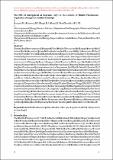Files in this item
The MIS 13 interglacial at Ceprano, Italy, in the context of Middle Pleistocene vegetation changes in southern Europe
Item metadata
| dc.contributor.author | Margari, V. | |
| dc.contributor.author | Roucoux, K. | |
| dc.contributor.author | Magri, D. | |
| dc.contributor.author | Manzi, G. | |
| dc.contributor.author | Tzedakis, P.C. | |
| dc.date.accessioned | 2019-09-27T23:37:36Z | |
| dc.date.available | 2019-09-27T23:37:36Z | |
| dc.date.issued | 2018-11-01 | |
| dc.identifier.citation | Margari , V , Roucoux , K , Magri , D , Manzi , G & Tzedakis , P C 2018 , ' The MIS 13 interglacial at Ceprano, Italy, in the context of Middle Pleistocene vegetation changes in southern Europe ' , Quaternary Science Reviews , vol. 199 , pp. 144-158 . https://doi.org/10.1016/j.quascirev.2018.09.016 | en |
| dc.identifier.issn | 0277-3791 | |
| dc.identifier.other | PURE: 256116580 | |
| dc.identifier.other | PURE UUID: 588341cb-1fd1-4403-b927-c8000c10b83f | |
| dc.identifier.other | RIS: urn:740A654E95419556C2E53BD8FBD8356B | |
| dc.identifier.other | Scopus: 85054027765 | |
| dc.identifier.other | WOS: 000448493900011 | |
| dc.identifier.other | ORCID: /0000-0001-6757-7267/work/64698079 | |
| dc.identifier.uri | https://hdl.handle.net/10023/18575 | |
| dc.description | PCT and VM gratefully acknowledge support from The Leverhulme Trust through a research project grant (F/00 122/AH) towards the palynological investigation of the Ceprano cores. Excavations 2001–2006 at Campogrande were directed by Itallo Biddittu and GM, authorized by the Soprintendenza Archeologica del Lazio and co-financed by research grants from the SAPIENZA, University of Rome. Drillings at Campogrande were jointly financed and supervised by the Istituto per la Dinamica dei Processi Ambientali (CNR, Venice) and by the Istituto Italiano di Paleontologia Umana (Rome). | en |
| dc.description.abstract | Climatic and environmental changes of the Middle Pleistocene in Europe provide the context for an important phase in the evolution and dispersal of early hominins. Pollen records from terrestrial and marine sediment sequences reveal patterns not usually visible in palaeoenvironmental reconstructions from archaeological sites alone and show that hominin evolution took place against a background of marked environmental change as forests expanded and contracted in concert with global and regional climatic shifts. It is rare to find archaeological material in stratigraphically long and continuous palaeoenvironmental sequences, yet this is what is needed to enable particular phases of hominin evolution to be securely associated with climatic and environmental changes. At the well-known Middle Pleistocene archaeological site of Ceprano in Italy we have been able to produce a pollen record from the sedimentary unit directly below the stratum of the hominin remains. The new pollen data from Ceprano are presented here in full for the first time and provide a detailed picture of interglacial vegetation development during Marine Isotope Stage (MIS) 13. This evidence contributes significantly to our knowledge of the spatial heterogeneity of ecosystem responses to climatic change during this period and helps to further constrain the age of the hominin remains. New sites combining both archaeology and long, continuous high quality palaeoecological records would help clarify the relationship between hominin presence and palaeoclimatic and palaeoenvironmental conditions. In the meantime, better communication between the research communities can also go a long way to improving our understanding of the links between the two. | |
| dc.format.extent | 15 | |
| dc.language.iso | eng | |
| dc.relation.ispartof | Quaternary Science Reviews | en |
| dc.rights | Copyright © 2018 Elsevier Ltd. This work has been made available online in accordance with the publisher’s policies. This is the author created, accepted version manuscript following peer review and may differ slightly from the final published version. The final published version of this work is available at https://doi.org/10.1016/j.quascirev.2018.09.016 | en |
| dc.subject | Middle Pleistocene | en |
| dc.subject | Pollen | en |
| dc.subject | Southern Europe | en |
| dc.subject | Vegetation | en |
| dc.subject | MIS 13 | en |
| dc.subject | Ceprano | en |
| dc.subject | Archaeology | en |
| dc.subject | GE Environmental Sciences | en |
| dc.subject | NDAS | en |
| dc.subject | SDG 14 - Life Below Water | en |
| dc.subject | SDG 15 - Life on Land | en |
| dc.subject.lcc | GE | en |
| dc.title | The MIS 13 interglacial at Ceprano, Italy, in the context of Middle Pleistocene vegetation changes in southern Europe | en |
| dc.type | Journal article | en |
| dc.description.version | Postprint | en |
| dc.contributor.institution | University of St Andrews. School of Geography & Sustainable Development | en |
| dc.identifier.doi | https://doi.org/10.1016/j.quascirev.2018.09.016 | |
| dc.description.status | Peer reviewed | en |
| dc.date.embargoedUntil | 2019-09-28 |
This item appears in the following Collection(s)
Items in the St Andrews Research Repository are protected by copyright, with all rights reserved, unless otherwise indicated.

